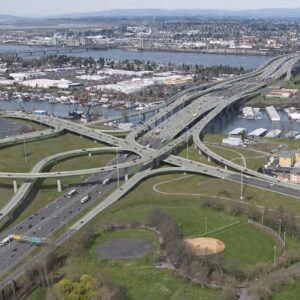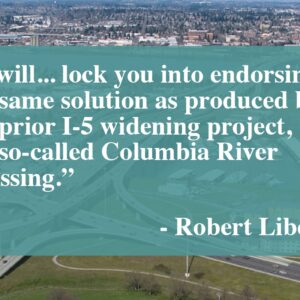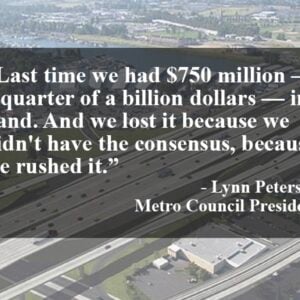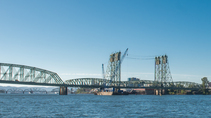
(Photo: Jonathan Maus/BikePortland)
Last week, the elected and agency officials who sit on the Executive Steering Group for the second attempt at the Columbia River Crossing project were elated to receive official word from the federal government that climate change and equity impacts won’t be directly centered in the project’s reboot. Celebrating that fact might seem odd, but the good mood around the virtual table that came from receiving written guidance from within USDOT seemed to stem from the fact that the project can now move along at a relatively quick pace.
“Based on our review, we believe the proposed modifications [to add climate and equity] to the FEIS [Final Environmental Impact Statement, a legally required document] are potentially substantial enough to require a new EIS and NEPA process, although additional information on precisely how the proposed modifications would affect the existing range of alternatives is needed before we could confirm this,” the regional heads of the Federal Highway Administration and the Federal Transit Administration wrote jointly in their letter (below) to the project team. A new EIS would add years to the project, an outcome that received essentially unanimous disapproval at last month’s meeting.
In other words, now that addressing climate change and equity are not explicitly issues that the Interstate Bridge Replacement Program is intended to address, work can begin to take the failed Columbia River Crossing project and polish it up to look like new.
Advertisement
Program administrator Greg Johnson insisted that the project will still examine climate change impacts and equity considerations very closely, but when those considerations go up against the already-approved project purpose, they almost certainly won’t win.
“… even if the program were to restart as a new project or pursue a Revised EIS, there is no guarantee that climate and equity would be able to be treated as transportation problems within a new Purpose and Need statement,” states the federal memo. “FHWA and FTA believe there are many opportunities to address climate change and equity with meaningful mitigation measures and actions.”
The project team made it clear that the work to polish off the CRC will only look at what’s changed since the design was developed over a decade ago. The steering group reviewed an image (below) of the project area with a few of those changes highlighted. Including things like “bridge type” and “number of auxiliary lanes” on the list of options that could be considered in response to those changes makes it seem like everything is still on the table; but any changes since 2011 will have to be big enough to justify changing the Locally Preferred Alternative selected for the CRC, which includes ten lanes on I-5, including two of those auxiliary lanes that ODOT is working to add to I-5 in the Rose Quarter.
Advertisement

The Executive Steering Group, as it celebrates the Feds encouraging the project team to keep the purpose and need exactly as it is, is trying to shift the focus onto outcomes. “I love the idea of actually starting with the end goal,” Commissioner Jo Ann Hardesty told the group. “If we are not weaving equity and climate mitigation into every story we tell about this project, then I think we will be failing our communities.”
This week the Metro Council will be discussing the project in a work session, and reviewing a set of draft outcomes they want to see from the project. Among the outcomes centered on reducing greenhouse gas emissions and improving air quality is, “a more efficient transportation system is achieved that improves traffic flow of the highway”. That outlook jibes very well with ODOT Director Kris Strickler (who worked on the CRC during his time at WSDOT) and his belief that freeway widening is a climate change strategy.
Of course, the issue of how the expected $3-4 billion price tag will be paid for is still outstanding. The pressure to pass a statewide transportation package in Washington decreased last week as Governor Jay Inslee vetoed sections of recently passed climate laws that kept them from taking effect if a new transportation revenue source wasn’t approved. However, the appetite for a large roads package among lawmakers is not likely to be significantly dampened by that move, and this project is one of only a few that gets namechecked nearly every time one comes up. Oregon lawmakers appear to be waiting for Washington to make the first move, which might not come until next spring.
The project team hopes to have a recommendation on a final project submitted to the bi-state legislative committee in charge of the project within a year. This month it became explicitly clear just how constrained the choices that will lead to that decision will be.
[pdf-embedder url=”https://bikeportland.org/wp-content/uploads/2021/05/ibr-cover-letter-and-federal-agency-response-pn_5-19-21_remediated-2.pdf”]
— Ryan Packer – ryan@theurbanist.org
— Get our headlines delivered to your inbox.
— Support this independent community media outlet with a one-time contribution or monthly subscription.






Thanks for reading.
BikePortland has served this community with independent community journalism since 2005. We rely on subscriptions from readers like you to survive. Your financial support is vital in keeping this valuable resource alive and well.
Please subscribe today to strengthen and expand our work.
Ah yes the feds… If you really want to kill this project, you need to get the Washington state legislature to do it in for you, same as last time.
I think the surest way to kill this is to get Clark county to hold their hard “no” to tolls and LRT. Disappointing the “We’re centering climate change in everything we do” Biden admin is already failing at keeping their word.
The problem is that Clark County no longer has any clout in any legislative or executive body that has control over this project. Both the WA and OR state legislatures are completely in control of Dems. The US House and Senate are both Dem. The nearest GOP Senator is in Idaho. Both governors are Dem. The only GOPer anywhere near this project is Jaime Herrera Beutler who is an ineffectual back bencher with zero clout in the House right now. All the other local GOPers are minority back benchers in the WA legislature with zero clout unlike 10 years ago.
Elections have consequences and one consequence is that Clark County Republicans have lost all ability to affect policy at the state or national level.
I think continuing to resist the Rose Quarter project is the best way to have this project re-imagined. If the Rose Quarter expansion gets built, then all of those additional lanes justify the bloated CRC design. If the Rose Quarter gets quashed or reduced, there is some impetus to redesign/reduce the CRC
goes both ways also. Each project justifies the other
The RQ is one additional auxiliary lane. For like a mile…
Yes, the RQ project is adding a lane in each direction. And those lanes will be used to justify adding extra lanes across the Columbia. This is a waste of money, space carbon and will simply induce demand and increase the already bad pollution. This is not a climate solution nor is it a traffic solution.
I’m a little confused by the quote from Commissioner Hardesty. Is Hardesty saying she supports the end project as outlined but wants a process that talks about equity? Is she opposing the project as outlined in 2011?
It appears that Hardesty is on the Executive Steering committee. Am I correct in reading that she celebrated not having to do a more formal review of equity impacts?
I for one will bet that this project never gets built. I think we are past the point where projects of this size get done anymore. When Rome was at it’s peak they built a viaduct system that would challenge us today. But after the empire collapsed they were hard pressed to even fix the leaks in the viaducts and sheep grazed in the coliseum. I think we are near that tipping point now. One day we will look up at the remains of the interstate bridge as we cross the river in wooden ferries and wonder what happened.
OK, I thought I was cynical.
I’m not arguing at all, you have a good point that we haven’t done a whole lot of impressive building unless it’s for a new high school stadium or something that benefits rich people. Hell, even that bridge with the huge crack in Memphis is getting “repaired” instead of replaced.
Thanks for the agreement, but I don’t think I am being cynical. Being cynical would mean that I am distrustful of peoples motivations and think no one does things for the public good but only to benefit themselves. While that may be true in some cases it is not why I think we won’t build the CRC. I think that as a country ( or an empire) we have lost the ability to accomplish hard things. Our latest commercial aircraft, chipmaking facilities, fighter aircraft and high tech warships are all abject failures. Our entire country is built around infrastructure with a 50 year lifespan that was built 60 years ago. A fair number of people think the moon landing was a hoax because we accomplished it 50 years ago with the computer power of a Furby and have not been able ( or willing) to go back since. It might just be the cyclical nature of history and our time is over. Or maybe the industrial age has burnt itself out and the earth will get a well deserved rest from our antics as we return to the tribes of hunters and gatherers from whence we came.
A single crack doesn’t mean that the structure will fail and needs to be replaced. Bridges like the one in Memphis can have members repaired or spliced and still go on to live long, useful lives.
The Memphis bridge has lived a long useful life. It was built 50 years ago with a design life of 50 years. Sure we have bridges much older than that, but as they get near (or pass) the 50 year life they become much more likely to fail. Like doing a daily 50 mile commute in a 1975 Ford Maverick, some people may do it, but they shouldn’t be surprised if the wheels fall off or the brakes fail.
The two bridges (I-40 in Memphis and I-5 in Portland) are not even remotely similar. The I-40 bridge is currently shut down and was constructed in the late-1960s. Seismic upgrades were begun 20 years ago to mitigate for the vulnerabilities of earthquakes in that region. The current fracture repair that caused the closure of the bridge is expected to take several months. No one would seriously consider a multi-year closure for a replacement bridge.
The newer of the I-5 bridges is almost 70 years old; the older one is 100+ years old; and the bridges are seismically vulnerable to even stronger earthquakes. Besides that, the I-5 bridges are lift-span bridges. The clearance of the I-40 bridge above the river is just about the same as was proposed for the CRC bridge in the first version.
At this point I’d take a ferry over the present situation if I could get myself, my kid and my bike to Portland without hearing loss or threat of violence….
You might be right. We can’t even fix potholes that have been there for 4 years.
PLANNING PUNCH LIST UPDATE NEEDED
Some other “loose pocket change” items to add to the update for the CRC2 / IBR project that were glossed over – due to federal rules – in how the parking garages / P+R hubs were scoped as to stalls and capacity (proportion of trips delivered to rapid transit stations by SOVs vs alt modes) and designed:
1) shared mobility / micro mobility [car share, scooters, bike share]
2) TNCs/ taxi and
3) real effective secure bike parking (aka Bikestation or similar).
Blumenauer’s / Cardin sponsored Bikeshare Transit Act will help some of this BUT the P+R work needs to be updated…and some of the parking structure sites have been or are being redeveloped so new sites (or new options to get people to the transit stops need to be facilitated).
PLUS the DOTs + Cities [with back up by CTRAN/ TRIMET] really need to also think harder about network improvements for walking and cycling to stations, especially those rapid transit stations without car parking (add secure shared bike locker parking [aka BikeLink etc] and add sidewalks for 1/4 mile radius to each station). CTRAN back in 2010s was still very much a traditional agency…KPIs/ outcomes were about moving vehicles and less so about moving people. Getting people off paratransit and able to use fixed route vehicles is easy money in the bank…based on cost per ride…if we can get the Feds to pay for the ADA sidewalk links. [Historically, Trimet and PBoT are much more savvy about this than CoV and CTRAN: just compare Fourth Plain BRT to any Trimet project.]
Agree with most of your points. However 1) Getting people off paratransit and able to use fixed route vehicles would take some major policy *and* design changes I don’t know if I trust Trimet to employ.
2) Implementing the ADA should not be about “comparatively good.” It’s been OVER 30 YEARS.
3) I am not going to pretend tO BE AN EXPERT ON BRT, but I don’t trust Trimet to get it right. It takes them months to agree to a job description. We’ll see what happens with their new GM.
‘
Here is the Link to CRC2 IBR Executive Steering Group ESG meeting via CVTV (Clark) – I did not see it above…

So with this and the BAC, Hardesty on transportation is apparently very conservative, pro car, and dismissive of equity proposals.
As far as I can tell, the Feds never clawed back the 100’s of millions of dollars wasted on CRC 1.0. I believe they had the legal authority to do so. I wish they would, or at least use it as a sword over the heads of the current negotiators. I know I know That’s extortion, but, hey Whatever Works.
Steve, the “sword” is still out there (>$300m?)…and that is one of the motivations to restart this project other than dire need. Though there has been some recent regional transportation projects that were cancelled after spending federal funds for planning and design that did not have to payback much (Hudson River rail tunnel replacements/ ARC, etc.)…from what I have read.
Jonathan — your photo shows I-5 at Lombard St.
The CRC Revision 1 only had improvements to I-5 as far south as Marine Dr.
Never as far south as even Victory Blvd/Denver Ave.
So your photo is an incorrect depiction of where we can expect to see a widened freeway. (I’m happy about that, BTW).
Ted Buehler
Remember “equity concerns” can be misused. Look at the recent use of “equity concerns” by PBOT to justify no bike lanes on Hawthorne. They can be misused to try to quash dissent. Many politicians use “equity concerns” to push through their desired plans. It’s a very strong tool as they can say you are racist if you object.
The Global Cities Initiatives matters here. The City of Portland signed onto GCI and its promise of helping cities prioritize transportation spending to facilitate international trade (hence, global cities, though it’s a program for American cities, created by Brookings Institute and MorganChase). Whatever feeble opposition Ted Wheeler pretended to have concerning the I-5 widening, it was never in doubt that he would ultimately take his cues from GCI on this (as he has on other items).